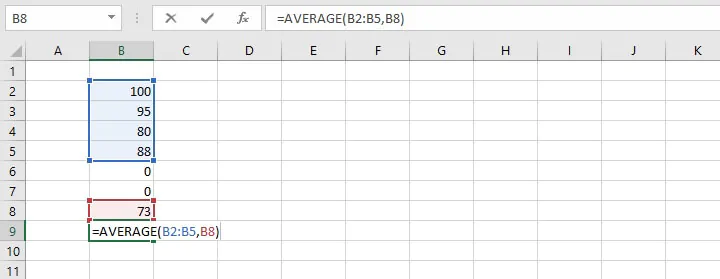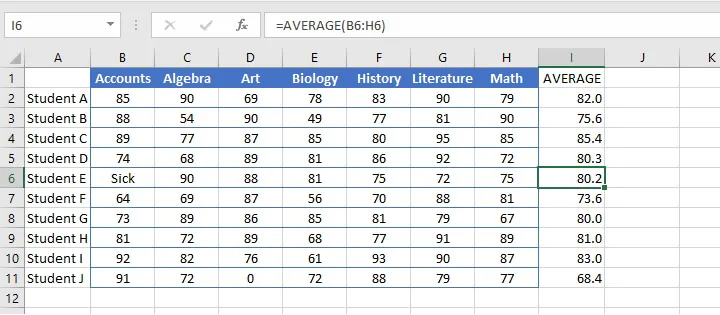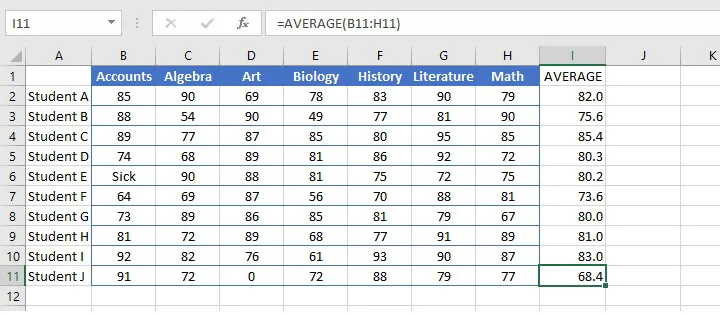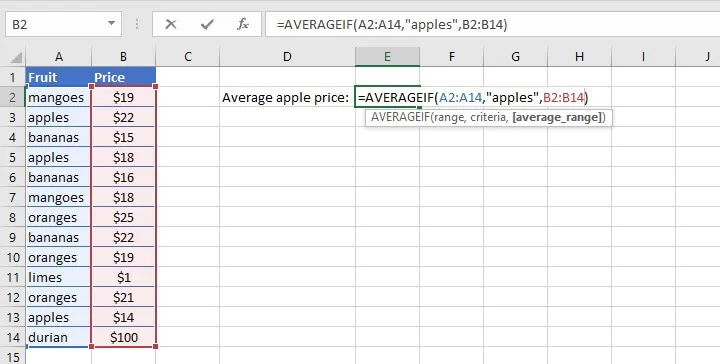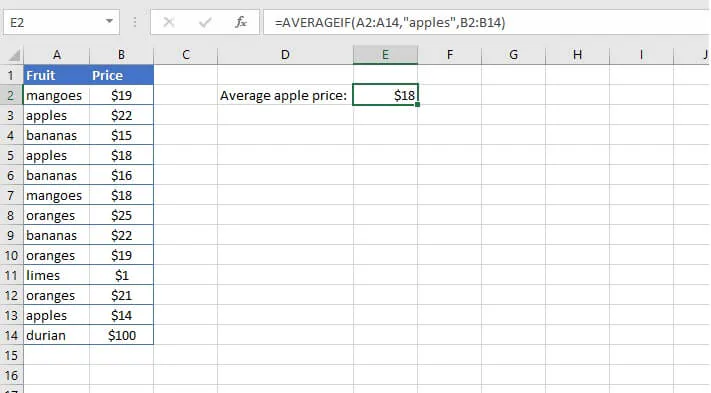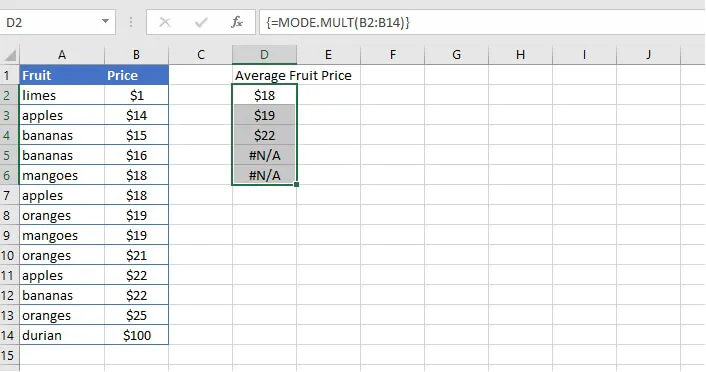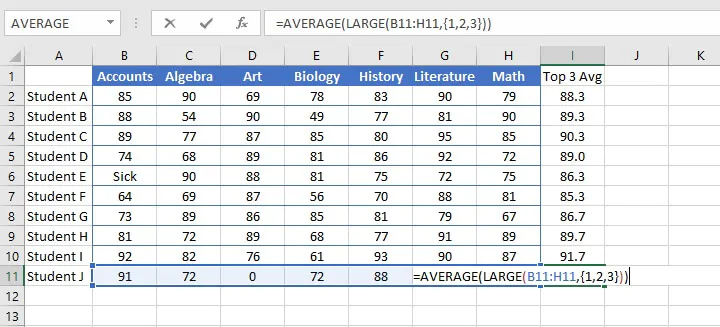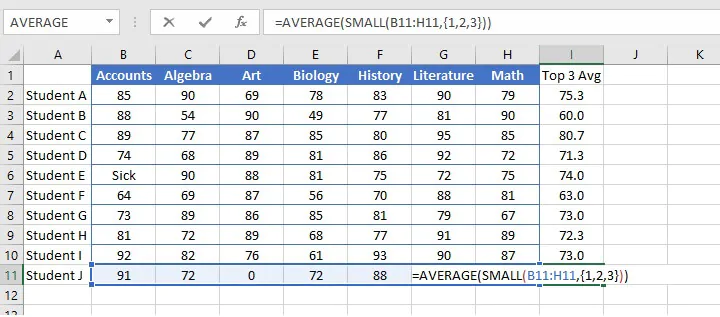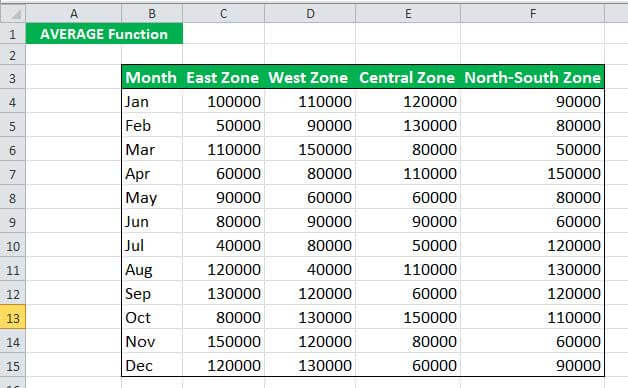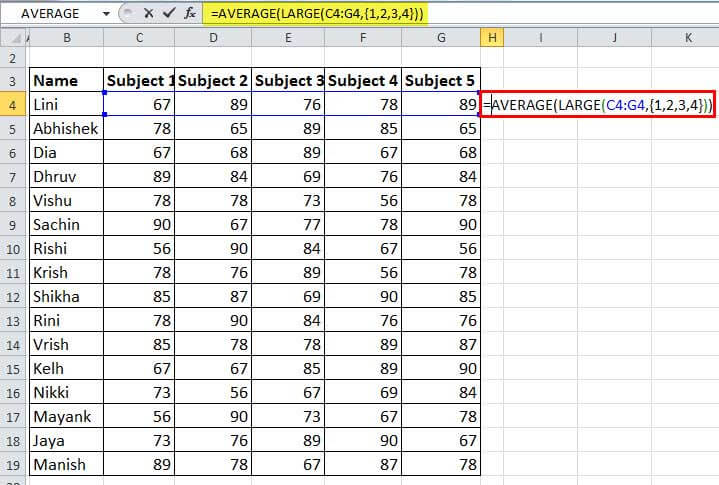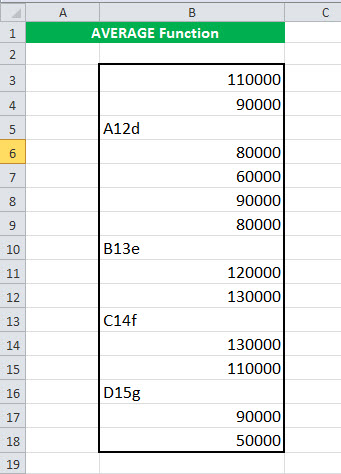Excel for Microsoft 365 Excel for Microsoft 365 for Mac Excel for the web Excel 2021 Excel 2021 for Mac Excel 2019 Excel 2019 for Mac Excel 2016 Excel 2016 for Mac Excel 2013 Excel 2010 Excel 2007 Excel for Mac 2011 Excel Starter 2010 More…Less
This article describes the formula syntax and usage of the AVERAGE function in Microsoft Excel.
Description
Returns the average (arithmetic mean) of the arguments. For example, if the range A1:A20 contains numbers, the formula =AVERAGE(A1:A20) returns the average of those numbers.
Syntax
AVERAGE(number1, [number2], …)
The AVERAGE function syntax has the following arguments:
-
Number1 Required. The first number, cell reference, or range for which you want the average.
-
Number2, … Optional. Additional numbers, cell references or ranges for which you want the average, up to a maximum of 255.
Remarks
-
Arguments can either be numbers or names, ranges, or cell references that contain numbers.
-
Logical values and text representations of numbers that you type directly into the list of arguments are not counted.
-
If a range or cell reference argument contains text, logical values, or empty cells, those values are ignored; however, cells with the value zero are included.
-
Arguments that are error values or text that cannot be translated into numbers cause errors.
-
If you want to include logical values and text representations of numbers in a reference as part of the calculation, use the AVERAGEA function.
-
If you want to calculate the average of only the values that meet certain criteria, use the AVERAGEIF function or the AVERAGEIFS function.
Note: The AVERAGE function measures central tendency, which is the location of the center of a group of numbers in a statistical distribution. The three most common measures of central tendency are:
-
Average, which is the arithmetic mean, and is calculated by adding a group of numbers and then dividing by the count of those numbers. For example, the average of 2, 3, 3, 5, 7, and 10 is 30 divided by 6, which is 5.
-
Median, which is the middle number of a group of numbers; that is, half the numbers have values that are greater than the median, and half the numbers have values that are less than the median. For example, the median of 2, 3, 3, 5, 7, and 10 is 4.
-
Mode, which is the most frequently occurring number in a group of numbers. For example, the mode of 2, 3, 3, 5, 7, and 10 is 3.
For a symmetrical distribution of a group of numbers, these three measures of central tendency are all the same. For a skewed distribution of a group of numbers, they can be different.
Tip: When you average cells, keep in mind the difference between empty cells and those containing the value zero, especially if you have cleared the Show a zero in cells that have a zero value check box in the Excel Options dialog box in the Excel desktop application. When this option is selected, empty cells are not counted, but zero values are.
To locate the Show a zero in cells that have a zero value check box:
-
On the File tab, click Options, and then, in the Advanced category, look under Display options for this worksheet.
Example
Copy the example data in the following table, and paste it in cell A1 of a new Excel worksheet. For formulas to show results, select them, press F2, and then press Enter. If you need to, you can adjust the column widths to see all the data.
|
Data |
||
|
10 |
15 |
32 |
|
7 |
||
|
9 |
||
|
27 |
||
|
2 |
||
|
Formula |
Description |
Result |
|
=AVERAGE(A2:A6) |
Average of the numbers in cells A2 through A6. |
11 |
|
=AVERAGE(A2:A6, 5) |
Average of the numbers in cells A2 through A6 and the number 5. |
10 |
|
=AVERAGE(A2:C2) |
Average of the numbers in cells A2 through C2. |
19 |
Need more help?
На чтение 1 мин
Функция СРЗНАЧ в Excel используется для вычисления среднего арифметического из заданного диапазона данных.
Содержание
- Что возвращает функция
- Синтаксис
- Аргументы функции
- Дополнительная информация
- Примеры использования функции СРЗНАЧ в Excel
Что возвращает функция
Возвращает число, соответствующее среднему арифметическому от заданного диапазона данных.

Синтаксис
=AVERAGE(number1, [number2], …) — английская версия
=СРЗНАЧ(число1;[число2];…) — русская версия
Аргументы функции
- number1 (число1) — первое число, диапазон чисел, из которого необходимо вычислить среднее арифметическое;
- [number2] ([число2]) (Опционально) — второе число, диапазон чисел, из которого необходимо вычислить среднее арифметическое. Максимальное количество аргументов функции — 255.
Дополнительная информация
- Аргументами функции СРЗНАЧ (AVERAGE) в Excel могут быть числа, именованные диапазоны, ссылки на ячейки, содержащие числовые значения;
- Ссылки на ячейки содержащими текст, логические значения или пустые ячейки игнорируются функцией. Вместе с тем, ячейки со значением «0» учитываются при вычислении среднего арифметического;
- Учитываются логические значения и текстовые представления чисел, которые вы вводите непосредственно в список аргументов;
- Аргументы с ошибками не могут быть учтены и использованы при работе функции.
Примеры использования функции СРЗНАЧ в Excel
Download Article
Download Article
Mathematically speaking, “average” is used by most people to mean “central tendency,” which refers to the centermost of a range of numbers. There are three common measures of central tendency: the (arithmetic) mean, the median, and the mode. Microsoft Excel has functions for all three measures, as well as the ability to determine a weighted average, which is useful for finding an average price when dealing with different quantities of items with different prices.
-
1
Enter the numbers you want to find the average of. To illustrate how each of the central tendency functions works, we’ll use a series of ten small numbers. (You won’t likely use actual numbers this small when you use the functions outside these examples.)
- Most of the time, you’ll enter numbers in columns, so for these examples, enter the numbers in cells A1 through A10 of the worksheet.
- The numbers to enter are 2, 3, 5, 5, 7, 7, 7, 9, 16, and 19.
- Although it isn’t necessary to do this, you can find the sum of the numbers by entering the formula “=SUM(A1:A10)” in cell A11. (Don’t include the quotation marks; they’re there to set off the formula from the rest of the text.)
-
2
Find the average of the numbers you entered. You do this by using the AVERAGE function. You can place the function in one of three ways:
- Click on an empty cell, such as A12, then type “=AVERAGE(A1:10)” (again, without the quotation marks) directly in the cell.
- Click on an empty cell, then click on the “fx” symbol in the function bar above the worksheet. Select “AVERAGE” from the “Select a function:” list in the Insert Function dialog and click OK. Enter the range “A1:A10” in the Number 1 field of the Function Arguments dialog and click OK.
- Enter an equals sign (=) in the function bar to the right of the function symbol. Select the AVERAGE function from the Name box dropdown list to the left of the function symbol. Enter the range “A1:A10” in the Number 1 field of the Function Arguments dialog and click OK.
Advertisement
-
3
Observe the result in the cell you entered the formula in. The average, or arithmetic mean, is determined by finding the sum of the numbers in the cell range (80) and then dividing the sum by how many numbers make up the range (10), or 80 / 10 = 8.
- If you calculated the sum as suggested, you can verify this by entering “=A11/10” in any empty cell.
- The mean value is considered a good indicator of central tendency when the individual values in the sample range are fairly close together. It is not considered as good of an indicator in samples where there are a few values that differ widely from most of the other values.
Advertisement
-
1
Enter the numbers you want to find the median for. We’ll use the same range of ten numbers (2, 3, 5, 5, 7, 7, 7, 9, 16, and 19) as we used in the method for finding the mean value. Enter them in the cells from A1 to A10, if you haven’t already done so.
-
2
Find the median value of the numbers you entered. You do this by using the MEDIAN function. As with the AVERAGE function, you can enter it one of three ways:
- Click on an empty cell, such as A13, then type “=MEDIAN(A1:10)” (again, without the quotation marks) directly in the cell.
- Click on an empty cell, then click on the “fx” symbol in the function bar above the worksheet. Select “MEDIAN” from the “Select a function:” list in the Insert Function dialog and click OK. Enter the range “A1:A10” in the Number 1 field of the Function Arguments dialog and click OK.
- Enter an equals sign (=) in the function bar to the right of the function symbol. Select the MEDIAN function from the Name box dropdown list to the left of the function symbol. Enter the range “A1:A10” in the Number 1 field of the Function Arguments dialog and click OK.
-
3
Observe the result in the cell you entered the function in. The median is the point where half the numbers in the sample have values higher than the median value and the other half have values lower than the median value. (In the case of our sample range, the median value is 7.) The median may be the same as one of the values in the sample range, or it may not.
Advertisement
-
1
Enter the numbers you want to find the mode for. We’ll use the same range of numbers (2, 3, 5, 5, 7, 7, 7, 9, 16, and 19) again, entered in cells from A1 through A10.
-
2
Find the mode value for the numbers you entered. Excel has different mode functions available, depending on which version of Excel you have.
- For Excel 2007 and earlier, there is a single MODE function. This function will find a single mode in a sample range of numbers.
- For Excel 2010 and later, you can use either the MODE function, which works the same as in earlier versions of Excel, or the MODE.SNGL function, which uses a supposedly more accurate algorithm to find the mode.[1]
(Another mode function, MODE.MULT returns multiple values if it finds multiple modes in a sample, but it is intended for use with arrays of numbers instead of a single list of values.[2]
)
-
3
Enter the mode function you’ve chosen. As with the AVERAGE and MEDIAN functions, there are three ways to do this:
- Click on an empty cell, such as A14 then type “=MODE(A1:10)” (again, without the quotation marks) directly in the cell. (If you wish to use the MODE.SNGL function, type “MODE.SNGL” in place of “MODE” in the equation.)
- Click on an empty cell, then click on the “fx” symbol in the function bar above the worksheet. Select “MODE” or “MODE.SNGL,” from the “Select a function:” list in the Insert Function dialog and click OK. Enter the range “A1:A10” in the Number 1 field of the Function Arguments dialog and click OK.
- Enter an equals sign (=) in the function bar to the right of the function symbol. Select the MODE or MODE.SNGL function from the Name box dropdown list to the left of the function symbol. Enter the range “A1:A10” in the Number 1 field of the Function Arguments dialog and click OK.
-
4
Observe the result in the cell you entered the function in. The mode is the value that occurs most often in the sample range. In the case of our sample range, the mode is 7, as 7 occurs three times in the list.
- If two numbers appear in the list the same number of times, the MODE or MODE.SNGL function will report the value that it encounters first. If you change the “3” in the sample list to a “5,” the mode will change from 7 to 5, because the 5 is encountered first. If, however, you change the list to have three 7s before three 5s, the mode will again be 7.
Advertisement
-
1
Enter the data you want to calculate a weighted average for. Unlike finding a single average, where we used a one-column list of numbers, to find a weighted average we need two sets of numbers. For the purpose of this example, we’ll assume the items are shipments of tonic, dealing with a number of cases and the price per case.
- For this example, we’ll include column labels. Enter the label “Price Per Case” in cell A1 and “Number of Cases” in cell B1.
- The first shipment was for 10 cases at $20 per case. Enter “$20” in cell A2 and “10” in cell B2.
- Demand for tonic increased, so the second shipment was for 40 cases. However, due to demand, the price of tonic went up to $30 per case. Enter “$30” in cell A3 and “40” in cell B3.
- Because the price went up, demand for tonic went down, so the third shipment was for only 20 cases. With the lower demand, the price per case went down to $25. Enter “$25” in cell A4 and “20” in cell B4.
-
2
Enter the formula you need to calculate the weighted average. Unlike figuring a single average, Excel doesn’t have a single function to figure a weighted average. Instead you’ll use two functions:
- SUMPRODUCT. The SUMPRODUCT function multiplies the numbers in each row together and adds them to the product of the numbers in each of the other rows. You specify the range of each column; since the values are in cells A2 to A4 and B2 to B4, you’d write this as “=SUMPRODUCT(A2:A4,B2:B4)”. The result is the total dollar value of all three shipments.
- SUM. The SUM function adds the numbers in a single row or column. Because we want to find an average for the price of a case of tonic, we’ll sum up the number of cases that were sold in all three shipments. If you wrote this part of the formula separately, it would read “=SUM(B2:B4)”.
-
3
Since an average is determined by dividing a sum of all numbers by the number of numbers, we can combine the two functions into a single formula, written as “=SUMPRODUCT(A2:A4,B2:B4)/ SUM(B2:B4)”.
-
4
Observe the result in the cell you entered the formula in. The average per-case price is the total value of the shipment divided by the total number of cases that were sold.
- The total value of the shipments is 20 x 10 + 30 x 40 + 25 x 20, or 200 + 1200 + 500, or $1900.
- The total number of cases sold is 10 + 40 + 20, or 70.
- The average per case price is 1900 / 70 = $27.14.
Advertisement
Ask a Question
200 characters left
Include your email address to get a message when this question is answered.
Submit
Advertisement
wikiHow Video: How to Calculate Averages in Excel
-
You do not have to enter all the numbers in a continuous column or row, but you do have to make sure Excel understands which numbers you want to include and exclude. If you only wanted to average the first five numbers in our examples on mean, median, and mode and the last number, you’d enter the formula as “=AVERAGE(A1:A5,A10)”.
Thanks for submitting a tip for review!
Advertisement
References
About This Article
Article SummaryX
To calculate averages in Excel, start by clicking on an empty cell. Then, type =AVERAGE followed by the range of cells you want to find the average of in parenthesis, like =AVERAGE(A1:A10). This will calculate the average of all of the numbers in that range of cells. It’s as easy as that! For step-by-step instructions with pictures, check out the full article below!
Did this summary help you?
Thanks to all authors for creating a page that has been read 185,303 times.
Is this article up to date?
How to calculate averages in Excel
Believe it or not, there are many different kinds of averages, and different ways to go about calculating them. The following methods are covered in this resource:
- AVERAGE
- AVERAGEA
- AVERAGEIF
- MEDIAN
- MODE
- Bonus: Nesting AVERAGE, LARGE and SMALL functions
AVERAGE
The most universally accepted average is the arithmetic mean, and Excel uses the AVERAGE function to find it. The Excel AVERAGE function is used to generate a number that represents a typical value from a range, distribution, or list of numbers. It is calculated by adding all the numbers in the list, then dividing the total by the number of values within the list.
Download your free average in Excel practice file!
Use this free average in Excel file to practice along with the tutorial.
Syntax
The AVERAGE function in Excel is straightforward. The syntax is:
=AVERAGE(number1, [number2],...)Ranges or cell references may be used instead of explicit values.
The AVERAGE function can handle up to 255 arguments, each of which may be a value, cell reference, or range. Only one argument is required, but of course, if you’re using the AVERAGE function, it’s likely you have at least two.
The formula below will calculate the average of the numbers 100, 95, and 80.
=AVERAGE(100,95,80)To calculate the average of values in cells B2, B3, B4, and B5 enter:
=AVERAGE(B2:B5)This can be typed directly into the cell or formula bar, or selected on the worksheet by selecting the first cell in the range, and dragging the mouse to the last cell in the range.
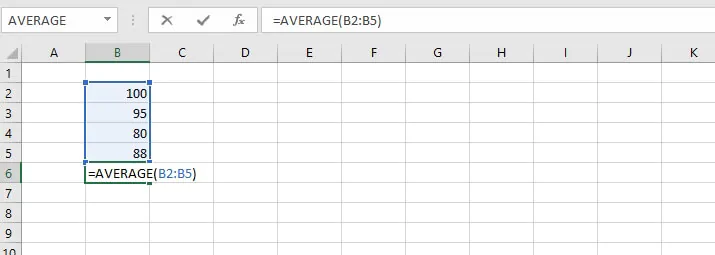
If typing the cell references directly into the cell or formula bar, non-contiguous references are separated by commas. For example:
=AVERAGE(B2:B5,B8)Remarks
When using the AVERAGE function, bear the following in mind.
- Text values and empty cells are ignored.
The word “Sick” in cell B6 (below) causes the AVERAGE function to ignore that cell altogether. This means that the average score in cell I6 was computed using the values in the range C8 to H8, and the total was divided by 6 subjects instead of 7.
- Zero values are included.
When determining the number of values to divide the total by, zeros are considered valid amounts and will therefore reduce the overall average of the distribution. Notice that Student J’s average is quite different from Student E’s average, even though their grade totals were similar.
AVERAGEA
In order to eliminate this discrepancy, the AVERAGEA function may be used to include all values within a distribution, including text. The format is similar:
=AVERAGEA(value1, [value2],...)A range or cell references may be used instead of explicit values.
AVERAGEA evaluates text values as zero, while the logical value TRUE is evaluated as 1. The logical value FALSE is considered a zero.
Compare the difference in results between using AVERAGE and AVERAGEA in the example below.
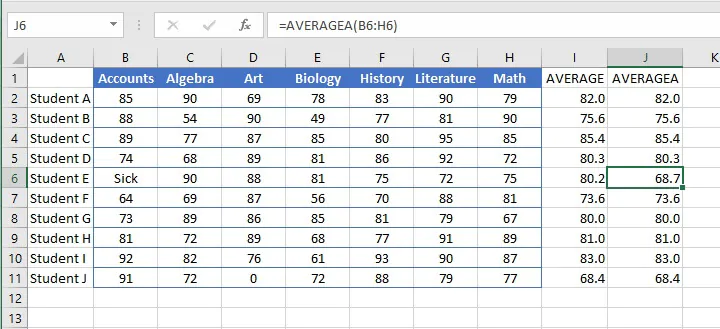
Check out the Microsoft Excel Basic & Advanced course
AVERAGEIF
There are ways to find the average of only the numbers that satisfy certain criteria. With the AVERAGEIF function, Excel looks within the specified range for a stated condition, and then finds the arithmetic mean of the cells that meet that condition.
The syntax of the AVERAGEIF function is:
=AVERAGEIF(range,criteria,[average_range])- The range is the location where we can expect to find cells that meet the criteria.
- The criteria are the value or expression that Excel should look for within the range.
- Average_range is an optional argument. This is the range of cells where the values to be averaged are located. If the average_range is omitted, the range is used.
AVERAGEIF example 1
For example, from this list of various fruit prices, we can ask Excel to extract only the cells that say “apples” in column A, and find their average price from column B.
AVERAGEIF example 2
The criteria in an AVERAGEIF function may also be in the form of a logical expression, as in the example below:
=AVERAGEIF(B4:H4,"<>0")The above formula will find the average of the values in the range B4 to H4 that are not equal to zero. Note that the third (optional) argument is omitted, therefore the cells in the range are used to calculate the average.
Since cells that are evaluated as zeros are omitted due to our criteria, notice the difference in Student E and J’s results below when using the AVERAGEIF function.
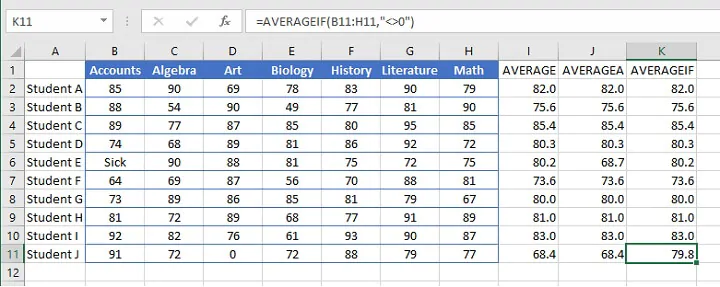
The arithmetic mean may be the most commonly-used method of finding the average, but it is by no means the only one. One outcome of using the arithmetic mean is that it allows very high or very low numbers to sway the outcome, thereby significantly altering the results.
Take for example, the following list of numbers:
22, 1, 14, 21, 15, 16, 18, 100, 19, 19, 22, 25, 18
Finding the arithmetic mean would give a result of 23.8.

Therefore, in some situations, it is more desirable to use the MEDIAN function. This function determines the numerical order of the values being evaluated and uses the one in the middle as the average.
The syntax is:
=MEDIAN(number1, [number2], …)A range or cell references may be used instead of explicit values.
In the above example, the numerical order would be:
1, 14, 15, 16, 18, 18, 19, 19, 21, 22, 22, 25, 100
There are 13 numbers in the distribution, making the seventh number the middle value. Therefore, the median would be 19.
If the number of values is an even number, the median would be determined by finding the average of the two numbers in the middle of the distribution. So, for the values 7,9,9,11,14,15 the median would be (9+11)/2=10.
The MEDIAN function ignores cells that contain text, logical values, or no value.
MODE
A third method for determining the average of a set of numbers is finding the mode, or the number that is repeated most often.
There are currently three “mode” functions within Excel. The classic, MODE, follows the syntax of:
=MODE(number1, [number2],...)In this function, Excel evaluates the values within the list or range, and selects the most frequently occurring number as the average value of the group.
However, there are occasions when more than one number could be considered the mode. For example, consider the following list:
1, 14, 15, 16, 18, 18, 19, 19, 21, 22, 22, 25, 100
The numbers 18, 19, and 22 each appear two times. Which one is the mode? Microsoft chooses the first-appearing value as the mode — in the above case, 18.

If the numbers were arranged in a random order, then Excel would select from 18, 19, and 22 based on whichever number appeared in the distribution first.
For example, in the list:
19, 22, 1, 14, 21, 15, 16, 18, 100, 19, 22, 25, 18
The MODE function considers 19 as the mode.
MODE.MULT
The MODE.MULT function is a solution to the discrepancies experienced in the above scenario. It allows us to anticipate and account for the possibility that there may be more than one mode within a group of numbers.
The syntax is:
=MODE.MULT(number1, [number2],...)Since MODE.MULT is an array (CSE) function, these are the steps when using this function:
- Select a vertical range for the output
- Enter the MODE.MULT formula
- Simultaneously select Control + Shift + Enter
Pressing Control + Shift + Enter (CSE) together will cause Excel to automatically place braces (curly brackets) around the formula, and will return a “spill” of results equal to the number of cells selected in Step 1. If there is more than one mode, they will be displayed vertically in the output cells. The MODE.MULT function will return the “#N/A” error if:
- there are no duplicate values, or
- there are no additional modes in the output range.
MODE.SNGL
Like the MODE.MULT function, the MODE.SNGL function was rolled out with Excel 2010. The syntax is:
=MODE.SNGL(number1, [number2],...]The MODE.SNGL function behaves like the classic MODE function in determining the output.
Creative uses of the AVERAGE function
Top 3
We can combine the AVERAGE function with the LARGE function to determine the average of the top “n” number of values.
The LARGE function extracts the nth largest number from a range, using the format
=LARGE(array, k)where k is the nth number.
Using this format, we can display a number in the 1st, 2nd, 5th, or any rank.
In order to get the average of the three largest numbers in a range, we would nest the AVERAGE and LARGE functions as follows:
=AVERAGE(LARGE(array, {1,2,3}))When we type braces around the k argument, Excel identifies the first, second, and third largest numbers in the array, and the AVERAGE function finds their average.
Bottom 3
We can use a similar logic to find the bottom 3 of a group of numbers using the SMALL function.
The following format will find the average of the three smallest numbers in the array.
=AVERAGE(SMALL(array, {1,2,3}))The three main methods of finding the average within Excel are the AVERAGE (mean), MEDIAN (middle), and MODE (frequency) functions. They are all easy to use, so choose the one that’s right for your type of data and the questions you want to answer.
Learn more Excel formulas and functions
To learn more useful formulas, functions, and real-world Excel skills, try the GoSkills Basic and Advanced Excel course today.
Ready to become a certified Excel ninja?
Start learning for free with GoSkills courses
Start free trial
The AVERAGE function in Excel calculates the arithmetic mean of the supplied values. Such values can be numbers, percentages or times. In the mean (or average), the sum of all the items is divided by the number of items on the list. Apart from numbers, an average of Boolean values (true and false) can also be found if they are typed directly in the AVERAGE formula.
For example, the formula “=AVERAGE(10,24,35,true,false)” returns 14. The “true” and “false” values are counted as 1 and 0 respectively. So, the mean is (10+24+35+1+0)/5=14.
The purpose of using the AVERAGE function in Excel is to calculate the center or meanArithmetic mean denotes the average of all the observations of a data series. It is the aggregate of all the values in a data set divided by the total count of the observations.read more of a list. A mean includes every value of the list in the calculation. As a result, it is impacted by the extreme values or outliers (very small or very big values) of a list. The AVERAGE function is categorized as a Statistical function of Excel.
Table of contents
- What is Average Function in Excel?
- Syntax of the AVERAGE Function of Excel
- Features of the AVERAGE function of Excel
- How to Use the AVERAGE Function of Excel?
- Example #1–Average in Five Different Cases
- Example #2–Average by Supplying a Horizontal Range Reference
- Example #3–Average and Maximum Average Revenue by AVERAGE, LOOKUP, and MAX Functions
- Example #4–Average of Top Four Scores by AVERAGE and LARGE Functions
- Example #5–Average of Last Three Numbers by AVERAGE, LOOKUP, LARGE, IF, ISNUMBER, and ROW Functions
- Frequently Asked Questions
- AVERAGE Function in Excel Video
- Recommended Articles
Syntax of the AVERAGE Function of Excel
The syntax of the AVERAGE function of Excel is shown in the following image:
The AVERAGE function of Excel accepts the following arguments:
- Number 1: This is the first number for which the average is to be calculated.
- Number 2, number 3,…number n: These are the subsequent numbers for which the average is to be calculated.
The numbers can be supplied as direct numbers, named ranges or cell referencesCell reference in excel is referring the other cells to a cell to use its values or properties. For instance, if we have data in cell A2 and want to use that in cell A1, use =A2 in cell A1, and this will copy the A2 value in A1.read more containing numeric values. The first number is required, while the subsequent numbers are optional. However, for computing an average, at least two numbers are needed.
Note: The output of other Excel functions can also serve as an input to the AVERAGE function. However, such an output must necessarily be a numeric value.
Features of the AVERAGE function of Excel
The features of the AVERAGE function of Excel are listed as follows:
- It can be supplied with a maximum of 255 arguments in a single formula.
- It ignores the logical values (or Boolean values) if they have been supplied as cell references. However, logical values entered directly in the formula are counted by the function.
- It counts those cell references that contain numbers formatted as text.
- It treats the text strings as follows:
- If the entire range reference consists of a few numbers and some text strings, the average of only the numbers is returned. In this case, the text strings supplied in the range reference are ignored by the function.
- If the entire range reference consists of text strings, the “#DIV/0!” error is returned by the function.
- If text strings are entered directly in the formula, it returns the “#VALUE!” error.
- It excludes the empty cells from the count. But, the cells containing the number zero are counted.
- It returns an error if the arguments supplied are error values.
Note: To include the zero values and exclude the empty cells from the count, follow the listed steps:
- Click “options” from the File tab. The “Excel options” window opens.
- Click “advanced” displayed on the left side.
- Under “display options for this worksheet,” select the checkbox of “show a zero in cells that have zero value.”
The zero values of cells will be displayed and included in the count by the AVERAGE function of Excel. Deselecting the checkbox in point “c” will hide the zero values and display empty cells in their place.
How to Use the AVERAGE Function of Excel?
The AVERAGE function is one of the most used functions of Excel. It is frequently used in the financial sectorThe financial sector refers to businesses, firms, banks, and institutions providing financial services and supporting the economy. It encompasses several industries, including banking and investment, consumer finance, mortgage, money markets, real estate, insurance, retail, etc.read more to calculate the average revenue generated by an organization in a specific time period. It is also used to do financial modelingFinancial modeling refers to the use of excel-based models to reflect a company’s projected financial performance. Such models represent the financial situation by taking into account risks and future assumptions, which are critical for making significant decisions in the future, such as raising capital or valuing a business, and interpreting their impact.read more and analyze datasets.
Let us consider a few examples to understand the working of the AVERAGE function of Excel.
You can download this AVERAGE Function Excel Template here – AVERAGE Function Excel Template
Example #1–Average in Five Different Cases
The following image shows a list of numbers in the range B3:B7. Use the AVERAGE function of Excel to perform the tasks stated within the following cases:
- Case 1: Calculate the average by supplying a vertical range reference.
- Case 2: Calculate the average by supplying the numbers directly to the function.
- Case 3: Calculate the average by supplying the numbers in words. Enclose the text strings within double quotation marks.
- Case 4: Calculate the average by supplying the references of cells containing the number names.
- Case 5: Calculate the average by supplying the numbers directly within double quotation marks.
Write a conclusion for each case.
Case 1: Supply a vertical range reference
The steps are listed as follows:
Step 1: Enter the following formula in cell C3.
“=AVERAGE(B3:B7)”
Step 2: Press the “Enter” key. The output in cell C3 is 4. So, the mean of the given numbers is 4. This is shown within a red box in the following image.
Conclusion: For calculating the average, the numbers can be supplied as a range reference. It is also possible to supply cell referencesCell reference in excel is referring the other cells to a cell to use its values or properties. For instance, if we have data in cell A2 and want to use that in cell A1, use =A2 in cell A1, and this will copy the A2 value in A1.read more of non-adjacent cells.
Simply select the cell or range in order to supply it to the AVERAGE function. Further, ensure that the non-contiguous cells or ranges are separated by commas.
Case 2: Supply the numbers directly to the AVERAGE function
The steps are listed as follows:
Step 1: Enter the following formula in cell C4.
“=AVERAGE(2,3,5,4,6)”
Step 2: Press the “Enter” key. The output is shown in cell C4 of the following image. Hence, the mean is again 4.
Conclusion: It is possible to supply the numbers directly to the AVERAGE function. One need not enclose such numbers within double quotation marks.
However, when there are too many numbers in the list, it becomes difficult to enter them directly. In such cases, it is easier to supply cell references.
Case 3: Supply the numbers in words
The steps are listed as follows:
Step 1: Enter the following formula in cell C5.
“=AVERAGE(“Two”,”Three”,”Five”,”Four”,”Six”)”
Step 2: Press the “Enter” key. The output in cell C5 is the “#VALUE!” error. This is shown in the following image.
Conclusion: When the number names are supplied directly to the AVERAGE function, it returns the“#VALUE!” error. This implies that the AVERAGE function does not work with text strings, even if such strings are enclosed within double quotation marks.
Case 4: Supply the references to cells containing the number names
The steps are listed as follows:
Step 1: Write the names of the numbers in the range A3:A7. Next, enter the following formula in cell C6.
“=AVERAGE(A3:A7)”
Step 2: Press the “Enter” key. The output in cell C6 is the “#DIV/0!” error. This is shown in the following image.
Conclusion: If number names are supplied as cell references, the AVERAGE function returns the “#DIV/0!” error. This implies that whether text strings are supplied directly or as cell references, the AVERAGE function does not work with them.
Notice the green triangles appearing on the top-left corner of cells C5 and C6. These triangles indicate that there is an error in the formulas of these cells.
Note: To include the text strings supplied as cell references, use the AVERAGEA function of Excel. This function counts such text strings as zero and ignores the empty cells. However, the text strings entered directly in the AVERAGEA formula can cause errors.
Case 5: Supply the numbers directly within double quotation marks
The steps are listed as follows:
Step 1: Enter the following formula in cell C7.
“=AVERAGE(“2”,“3”,“5”,“4”,“6”)”
Step 2: Press the “Enter” key. The output in cell C7 is 4. Hence, the mean is 4. This is shown within a red box in the following image.
Conclusion: If numbers are supplied directly within double quotation marks, the AVERAGE function returns their average (or mean). Hence, whether numbers are supplied as cell references or direct values (with or without double quotation marks), the AVERAGE function returns their mean.
Example #2–Average by Supplying a Horizontal Range Reference
The following image shows the names (column C), IDs (column B), and scores (in five subjects in columns D to H) of 20 students of a class. Given that the maximum marks of each subject are 100, calculate the average score obtained by each student.
Use the AVERAGE function of Excel.
The steps to calculate the average are listed as follows:
Step 1: Enter the following formula in cell I4.
“=AVERAGE(D4:H4)”
So, we have supplied the cell references of row 4 to the AVERAGE function of Excel.
Step 2: Press the “Enter” key. The output in cell I4 is 79.4. Hence, the average score of the student Ashwin is 79.4.
Step 3: Drag the formula of cell I4 till cell I23. For dragging, use the excel fill handleThe fill handle in Excel allows you to avoid copying and pasting each value into cells and instead use patterns to fill out the information. This tiny cross is a versatile tool in the Excel suite that can be used for data entry, data transformation, and many other applications.read more appearing at the bottom-right side of cell I4.
The outputs are shown in the following image. The formula bar shows the formula of the currently selected cell (I23).
Example #3–Average and Maximum Average Revenue by AVERAGE, LOOKUP, and MAX Functions
The following image shows the monthly revenuesRevenue is the amount of money that a business can earn in its normal course of business by selling its goods and services. In the case of the federal government, it refers to the total amount of income generated from taxes, which remains unfiltered from any deductions.read more (in $ in columns C to F) generated by an organization from four zones, namely, east, west, central, and north-south. We want to perform the listed tasks:
- Calculate the average revenue for each month.
- Calculate the average revenue for each zone.
- Find the zone with the maximum average revenue.
Use the AVERAGE function of Excel for tasks “a” and “b.” For task “c,” use the LOOKUP and MAX functions. Further, explain the formula used for task “c.”
a. The steps to calculate the average revenue for each month are listed as follows:
Step 1: Enter the following formula in cell C18.
“=AVERAGE(C4:F4)”
Since the average for each row of the dataset needs to be calculated, we have supplied the range reference of row 4.
Step 2: Press the “Enter” key to obtain the output. This is shown in cell C18 of the following image. So, the average revenue for January is $105,000.
Step 3: Drag the formula of cell C18 till cell C29 with the help of the fill handle. The average revenues for all the months are shown in the following image. In this image, the formula bar displays the formula of the currently active cell (C29).
b. The steps to calculate the average revenue for each zone are listed as follows:
Step 1: Enter the following formula in cell G18.
“=AVERAGE(C4:C15)”
This time we supply the cell references of column C in the AVERAGE formula. This is because the average for the entire column needs to be calculated.
Step 2: Press the “Enter” key. The output of cell G18 is shown in the following image. Likewise, we have entered the following formulas in cells G19, G20, and G21 respectively:
• “=AVERAGE(D4:D15)”
• “=AVERAGE(E4:E15)”
• “=AVERAGE(F4:F15)”
Hence, the averages for each zone have been calculated in the range G18:G21.
c. The steps to find the zone with the maximum average revenue are listed as follows:
Step 1: Enter the following formula in cell H18.
“=LOOKUP(MAX(G18:G21),G18:G21,F18:F21)”
This is shown in the following image.
Step 2: Press the “Enter” key. The output is shown in the following image. Hence, the average revenue of the west zone is maximum.
Explanation of the formula: In the formula of step 1, we have used the vector form of the LOOKUP function. This formula works as follows:
- The MAX functionThe MAX Formula in Excel is used to calculate the maximum value from a set of data/array. It counts numbers but ignores empty cells, text, the logical values TRUE and FALSE, and text values.read more looks for the maximum number of the range G18:G21. The output of the MAX function is 100000. This output becomes the “lookup_value” of the LOOKUP function.
- Next, the LOOKUP functionThe LOOKUP excel function searches a value in a range (single row or single column) and returns a corresponding match from the same position of another range (single row or single column). The corresponding match is a piece of information associated with the value being searched.
read more searches the number 100000 (lookup_value) in the range G18:G21 (lookup_vector). It returns the result from the range F18:F21 (result_vector). So, the given “lookup_value” corresponds with the west zone.
Hence, the output of the formula of step 1 is “west zone.”
Note: The LOOKUP function searches for a value (lookup_value) in a one-row or one-column range (lookup_vector) and returns a corresponding match from the same position of another range (result_vector). The MAX function returns the maximum number from a dataset of numeric values.
For the syntax of the LOOKUP and MAX functions, click the hyperlinks of points “b” and “a” respectively.
Example #4–Average of Top Four Scores by AVERAGE and LARGE Functions
The following image shows the names (column B) and scores (columns C to G) of 16 students in five subjects. We want to perform the listed tasks:
- Calculate the average of five scores of the student Lini (row 4). Use the AVERAGE function of Excel.
- Calculate the average of the top four scores of each student. Use the AVERAGE and LARGE functions of Excel.
Explain the formula used for task “b.”
a. The steps to calculate the average of the five scores of row 4 are listed as follows:
Step 1: Enter the following formula in cell H4.
“=AVERAGE(C4:G4)”
Step 2: Press the “Enter” key. The output is 79.8, as shown in the following image. Hence, Lini’s average of five scores is 79.8.
Note: To find the average (of five scores) for all the students, simply drag the formula of cell H4 till cell H19. For dragging, use the fill handle at the bottom-right corner of cell H4.
b. The steps to calculate the average of the top four scores of each student are listed as follows:
Step 1: Enter the following formula in cell H4.
“=AVERAGE(LARGE(C4:G4,{1,2,3,4}))”
Step 2: Press the “Enter” key. The output is shown in cell H4 of the following image. Hence, Lini’s average of the top four scores is 83.
Step 3: Drag the formula of cell H4 till cell H19. The outputs for all rows are shown in the following image. Notice that all these outputs are the averages of the top four scores of each student.
Explanation of the formula: In the formula of step 1, the inner function (LARGE function) is processed first, followed by the outer function (AVERAGE function). This formula works as follows:
- An array of numbers {1,2,3,4} has been supplied to the LARGE functionLARGE Function returns the nth largest value from a given set of values. It is a built-in function of Microsoft Excel and is categorized as a Statistical Excel Function. read more. These numbers represent the position from which values will be returned. So, the LARGE function searches for the first highest, second highest, third highest, and fourth highest values in the range C4:G4. As a result, the LARGE function returns an array of numbers, which is {89,89,78,76}.
- The array of numbers returned by the LARGE function {89,89,78,76} serves as the argument of the AVERAGE function. The AVERAGE function calculates the average of these numbers, which is (89+89+78+76)/4=83.
Likewise, the average of the top four scores has been obtained for all the students of the range B4:B19.
Note: The LARGE function returns a value from the specified position of the supplied range. This position begins from the highest value of the dataset. So, the number 1 corresponds to the maximum value of the dataset, 2 corresponds to the second highest value, 3 corresponds to the third highest value, and so on.
For the syntax of the LARGE function, click the hyperlink given in point “a” of the preceding explanation.
Example #5–Average of Last Three Numbers by AVERAGE, LOOKUP, LARGE, IF, ISNUMBER, and ROW Functions
The following image shows some numeric and textual values in column B. Calculate the average of the last three numeric values, which are in cells B15, B17, and B18.
Use the AVERAGE, LOOKUP, LARGE, IF, ISNUMBER, and ROW functions of Excel. Further, explain the formula used for the given task.
The steps to calculate the average of the last three numeric cells are stated as follows:
Step 1: Enter the following formula in cell C3.
“=AVERAGE(LOOKUP(LARGE(IF(ISNUMBER(B3:B18),ROW(B3:B18)),{1,2,3}),ROW(B3:B18),B3:B18))”
Step 2: Press the keys “Ctrl+Shift+Enter” together. For Excel for Mac, press the keys “Command+Shift+Enter.”
Once the CSE (Ctrl+Shift+Enter) keys are pressed, the formula is enclosed within curly braces. This is shown in the following image. The output is also shown in cell C3.
Hence, the average of the last three numeric values (110000, 90000, and 50000) is 83333.3.
Explanation of the formula: The formula of step 1 works as follows:
a. In the formula “ISNUMBER(B3:B18),ROW(B3:B18),” the ROW functionThe row function in Excel is a worksheet function that displays the current row index number of the selected or target cell. The syntax to use this function is as follows: =ROW( Value ).read more returns the row numbers of the range B3:B18. So, the ROW function returns the following array of values:
{3;4;5;6;7;8;9;10;11;12;13;14;15;16;17;18}.
b. The ISNUMBER functionISNUMBER function in excel is an information function that checks if the referred cell value is numeric or non-numeric.read more processes each value returned by the ROW function. The ISNUMBER function returns “true” if a cell of column B contains a number. It returns “false” if a cell of column B contains a text string. Consequently, the ISNUMBER function returns the following array of logical values:
{TRUE;TRUE;FALSE;TRUE;TRUE;TRUE;TRUE;FALSE;TRUE;TRUE;FALSE;TRUE;TRUE;FALSE;TRUE;TRUE}
c. Next, the IF functionIF function in Excel evaluates whether a given condition is met and returns a value depending on whether the result is “true” or “false”. It is a conditional function of Excel, which returns the result based on the fulfillment or non-fulfillment of the given criteria.
read more operates. The “logical_test” of the IF function is “ISNUMBER(B3:B18)” and the “value_if_true” is “ROW(B3:B18).” The “value_if_false” has been omitted. Therefore, the IF function processes each value of the array returned by the ISNUMBER function. The IF function returns the row number for each “true” value and “false” for each “false” value. So, the IF function returns the following array of values:
{3;4;FALSE;6;7;8;9;FALSE;11;12;FALSE;14;15;FALSE;17;18}
d. The LARGE function has been supplied the array {1,2,3} in the formula “LARGE(IF(ISNUMBER(B3:B18),ROW(B3:B18)),{1,2,3}).” So, the LARGE function searches for the first highest, second highest, and third highest values in the array returned by the IF function. The LARGE function returns the following array of three values:
{18,17,15}
e. Next, the LOOKUP function processes the formula “LOOKUP({18,17,15},ROW(B3:B18),B3:B18).” So, the LOOKUP function searches for the values 18, 17, and 15 in the array returned by the formula “ROW(B3:B18).” The array returned by this ROW formula is the same as that of point “a.” Therefore, the LOOKUP function returns a corresponding match of the values 18, 17, and 15 from the range B3:B18. As a result, the following array is returned by the LOOKUP function:
{50000,90000,110000}
f. Finally, the AVERAGE function calculates the mean of the three values returned by the LOOKUP function. It returns 83333.3 [(50000+90000+110000)/3] as the average.
Notice that the formula of step 1 works as an array formula as it has been completed by pressing the CSE (Ctrl+Shift+Enter) keys. Therefore, the LOOKUP function also returns an array of corresponding matches (50000, 90000, and 110000) for the multiple “lookup_values” (18, 17, and 15) supplied to it.
However, the regular LOOKUP function looks for a single “lookup_value” and returns a single corresponding match. Moreover, it is completed by pressing the “Enter” key.
Note 1: The ROW function returns the row numbers of the supplied cell reference. The ISNUMBER function checks whether the supplied value or cell reference is numeric or not. It returns “true” if the supplied value (or reference) is numeric, otherwise it returns “false.”
The IF function checks whether the supplied condition (logical_test) is true or false. If the condition is true, it returns the “value_if_true.” If the condition is false, it returns the “value_if_false.” If the logical test evaluates to false and the “value_if_false” is omitted, the IF function returns “false.”
For the syntax of the ROW, ISNUMBER, and IF functions, click the hyperlinks given in points “a,” “b,” and “c” of the preceding explanation. The definitions of the LOOKUP and LARGE functions are given in the notes at the end of examples #3 and #4 respectively.
Note 2: To view the array returned by each function, follow the listed steps:
- Select cell C3 that contains the formula.
- Double-click within the selected cell. Alternatively, press the key F2 to enter the Edit mode.
- Select that part of the formula whose array needs to be viewed. For instance, to view the array returned by the ISNUMBER function, select “ISNUMBER(B3:B18).”
- Press the key F9 once a selection has been made in the preceding step.
To stop editing the formula, press the escape (Esc) key.
Frequently Asked Questions
1. Define the AVERAGE function and suggest how to calculate the average in Excel.
The AVERAGE function of Excel calculates the average of the supplied numeric values. The function can be supplied with either direct numbers or references to cells containing numbers. However, the AVERAGE function does not work with text values.
To calculate the average in Excel, follow either of the listed methods:
• Add the numbers of the list manually. Divide the sum obtained by the number of values of the list.
• Open the AVERAGE formula by typing “=AVERAGE” without the beginning and ending double quotation marks. Supply the numbers (enclosed in parentheses) whose average is to be calculated. Press the “Enter” key.
Note: For the syntax of the AVERAGE function, refer to the heading “syntax of the AVERAGE function of Excel,” which is given after the introduction of this article.
2. Define the different varieties of the AVERAGE function of Excel.
In Excel 2007 and the subsequent versions, the following varieties of the AVERAGE function are available:
a. AVERAGEA function–It calculates the average by including the text values (supplied as cell references), Boolean values (true and false), and numeric values. It ignores the empty cells from the count. If the text values are entered directly in the formula, it results in errors. Supplying error values to the formula also causes errors.
b. AVERAGEIF function–It calculates the average of those cells that meet a particular criterion (condition). The criterion, range against which criterion is evaluated, and the actual range to be averaged are supplied to the function as arguments.
c. AVERAGEIFS function–It calculates the average of those cells that meet particular criteria (conditions). This function can be supplied multiple conditions and multiple ranges against which the conditions are to be evaluated. The actual range to be averaged also needs to be supplied as an argument.
Note: The AVERAGEA function of Excel counts the cell references containing text values as zero. It counts “true” and “false” values as 1 and 0 respectively. The AVERAGEA function counts the Boolean values irrespective of whether they are supplied directly or as cell references.
3. Where is the AVERAGE function on the Excel ribbon and how is it used?
The AVERAGE function is within the AutoSum drop-down of the Home tab (“editing” group) and the Formulas tab (“function library” group). To use this function, follow the listed steps:
a. Select the cell immediately below the cells to be averaged.
b. Click the AVERAGE function from the AutoSum drop-down. The AVERAGE formula automatically appears in Excel.
c. Verify the range of the formula and if correct, press the “Enter” key.
The average for the column is returned.
Note 1: Once the AVERAGE formula appears in the selected cell of Excel, its range can be edited manually, if required.
Note 2: To find an average for a row, select the cell to the immediate right of the cells to be averaged. Next, follow the steps “b” and “c” stated above.
AVERAGE Function in Excel Video
Recommended Articles
This has been a guide to the AVERAGE function in Excel. Here we explain how to calculate Average using AVERAGE formula in Excel along with examples and downloadable Excel templates. You may also look at these useful functions of Excel–
- Weighted Average ExcelIn Excel, we calculate Weighted Average by assigning weights to each data set. It is generally used to compute robust observations in statistics or portfolios and is calculated as (w1x1+w2x2+….+wnxn)/(w1+w2+..wn), where w is the weight allocated to the x value and the sumproduct function is used.read more
- LARGE Function in Excel
- Weighted Average Formula
- SUMPRODUCT Function in ExcelThe SUMPRODUCT excel function multiplies the numbers of two or more arrays and sums up the resulting products.read more
















